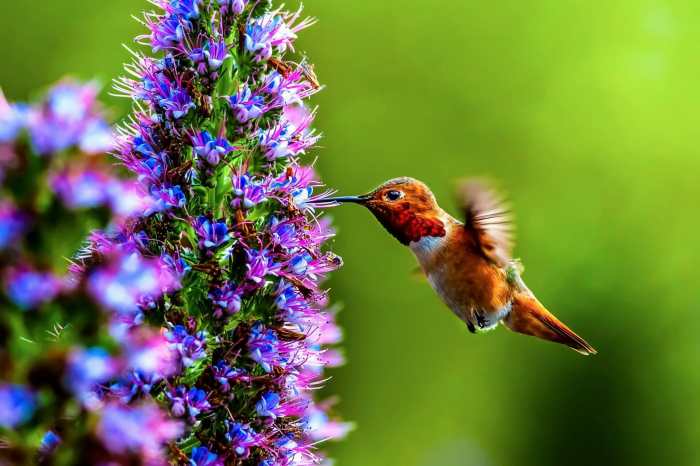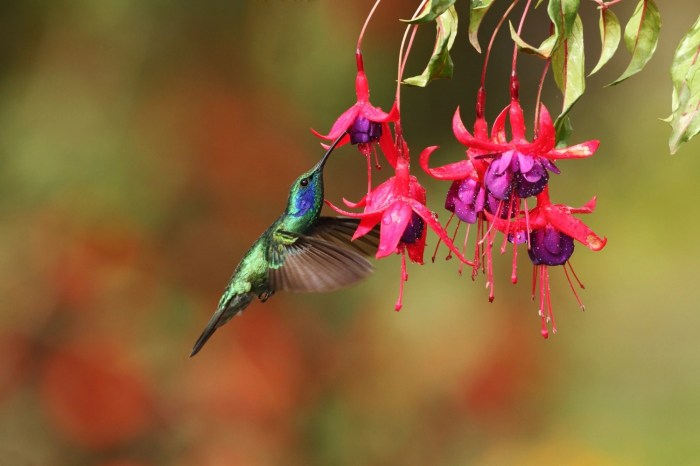Hanging plants to attract hummingbirds is an art form that not only beautifies your outdoor space but also invites these fascinating creatures to visit. These vibrant, nectar-loving birds are a joy to watch, and hanging plants provide them with the perfect environment to thrive.
From choosing the right plants to creating a hummingbird-friendly oasis, this comprehensive guide will help you transform your outdoor space into a haven for these tiny aerial acrobats.
Popular Hanging Plants for Hummingbirds
Hanging plants offer a vibrant and practical way to attract hummingbirds to your outdoor space. These aerial acrobats are drawn to specific plant characteristics that make them ideal for hanging planters.
Hummingbirds prefer plants with bright colors, such as red, orange, and yellow. They are also attracted to flowers that are rich in nectar and have tubular shapes, which allow them to easily access the sweet liquid. Additionally, hanging plants provide vertical gardening opportunities, creating more space for these birds to feed and nest.
Hanging Plants for Hummingbirds
- Fuchsia: Fuchsia plants produce clusters of bell-shaped flowers in vibrant shades of pink, purple, and white, which hummingbirds find irresistible.
- Lantana: Lantana offers a profusion of small, colorful flowers in a range of hues, including yellow, orange, red, and purple. Its compact growth habit makes it ideal for hanging baskets.
- Petunia: Petunias are known for their trumpet-shaped flowers that come in a wide variety of colors. They bloom profusely and are a favorite of hummingbirds.
- Salvia: Salvia plants produce spikes of tubular flowers that are rich in nectar. Hummingbirds are particularly attracted to the scarlet and purple varieties.
- Mandevilla: Mandevilla is a vine that produces large, trumpet-shaped flowers in shades of pink, red, and yellow. Its cascading growth habit makes it a stunning choice for hanging baskets.
Designing a Hummingbird-Attracting Hanging Garden

Creating a hanging garden specifically designed to attract hummingbirds requires careful consideration of location, plant selection, and arrangement. The ideal site should offer ample sunlight, protection from strong winds, and proximity to a water source. By choosing a variety of plants that bloom at different times throughout the year, you can ensure a continuous supply of nectar for your feathered visitors.
Arranging Hanging Plants for Visual Appeal and Functionality
When arranging hanging plants, aim for a visually appealing and functional design. Consider the height, shape, and color of the plants to create a pleasing aesthetic. Place taller plants in the center or back of the arrangement, with shorter plants in front.
Use a variety of hanging baskets and trellises to add height and interest. Position the plants close enough together to create a sense of abundance, but not so close that they crowd each other out.
Maximizing Space with Vertical Trellises and Hanging Baskets
To maximize space and attract more hummingbirds, consider using vertical trellises or hanging baskets. Trellises can be used to support climbing plants, such as honeysuckle or trumpet vine, which can reach heights of up to 20 feet. Hanging baskets can be filled with a variety of flowering plants, such as fuchsia, lobelia, or petunias.
By placing these baskets at different heights, you can create a tiered effect that is both visually appealing and attractive to hummingbirds.
Care and Maintenance of Hanging Plants for Hummingbirds

To ensure the health and vitality of hanging plants that attract hummingbirds, specific care requirements must be met. This includes regular watering, fertilizing, and pruning, as well as protection against common pests and diseases.
Watering
Hanging plants require consistent watering, especially during hot and dry weather. Allow the top inch of soil to dry out before watering thoroughly. Avoid overwatering, as this can lead to root rot. Use lukewarm water and avoid using tap water that contains chlorine or fluoride, as these chemicals can harm the plants.
Fertilizing
Fertilize hanging plants every two to three weeks during the growing season with a balanced liquid fertilizer. Follow the instructions on the fertilizer label carefully to avoid over-fertilizing, which can damage the plants.
Pruning
Regular pruning helps to maintain the shape and health of hanging plants. Remove dead or damaged leaves and stems, and pinch back the tips of growing shoots to encourage bushier growth. Pruning should be done in the spring or fall when the plants are not actively flowering.
Pest and Disease Control
Common pests that can affect hanging plants include aphids, spider mites, and mealybugs. Natural remedies for controlling these pests include spraying the plants with a mixture of water and insecticidal soap or neem oil. Diseases that can affect hanging plants include powdery mildew and botrytis.
These diseases can be prevented by providing good air circulation and avoiding overwatering.
Hanging plants are a great way to attract hummingbirds to your garden, providing a vibrant and inviting environment for these feathered visitors. While some may question the feng shui of hanging plants, some cultures believe that they can bring bad luck are hanging plants bad luck . However, when it comes to attracting hummingbirds, hanging plants remain an excellent choice, as their colorful blooms and nectar-rich flowers create an irresistible haven for these aerial acrobats.
Creating a Hummingbird Habitat with Hanging Plants
Providing a suitable nesting environment is crucial for attracting hummingbirds. Hanging plants offer a convenient and natural solution for creating nesting sites and enhancing the overall hummingbird habitat.
Hummingbirds prefer nesting in secluded, protected areas with access to ample food sources. Hanging plants, with their dense foliage and hanging growth habit, provide ideal nesting spots. The dense foliage conceals the nest from predators, while the hanging nature offers protection from wind and rain.
Nesting Boxes
Creating a nesting box specifically designed for hummingbirds can further enhance their nesting success. Nesting boxes should be small, measuring approximately 4 inches wide and 6 inches tall. They should have a small entrance hole, around 1 inch in diameter, and be made of breathable materials like wood or wicker.
Place the nesting box in a sheltered area with ample shade, such as under a hanging plant or in the shade of a tree. Line the box with soft materials like cotton balls or moss to provide a comfortable nesting environment.
Natural Nesting Materials
Hummingbirds also readily use natural materials for nesting. Providing access to materials like spider webs, plant fibers, and soft plant materials can encourage them to build nests in hanging plants.
Hang bundles of spider webs or plant fibers from the hanging plants to create a framework for the nest. Soft plant materials, such as dandelion fluff or cottonwood fluff, can be placed nearby to provide insulation and comfort.
Hanging plants are an excellent way to attract hummingbirds to your garden, and Bunnings wall hanging pots provide a convenient and stylish way to display them. These pots are designed to be hung on walls or fences, making them ideal for small spaces or areas where floor space is limited.
By incorporating hanging plants into your garden, you can create a welcoming environment for hummingbirds, providing them with a source of nectar and shelter.
Water Features
Water is essential for hummingbirds, and providing a water source in their habitat will attract them and encourage them to stay longer.
Install a birdbath or mister near the hanging plants. The birdbath should be shallow, no more than 2 inches deep, and have a rough surface to provide grip for the hummingbirds. Misters create a fine spray of water that mimics natural rainfall, which hummingbirds enjoy flying through and bathing in.
Hummingbirds are known to be attracted to brightly colored, nectar-producing flowers. Hanging plants are a great way to provide these birds with a food source while also adding a touch of beauty to your home. However, not all hanging plants can tolerate the full sun that hummingbirds prefer.
If you’re looking for a hanging plant that can handle the heat, consider one of the many varieties of hanging plants that can tolerate full sun . These plants will provide your hummingbirds with a place to feed and rest, while also adding a splash of color to your garden.
Enhancing the Aesthetic Appeal of Hanging Plants for Hummingbirds

Hanging plants not only provide sustenance for hummingbirds but can also elevate the visual appeal of outdoor spaces. Here are some ideas to enhance the aesthetic charm of your hummingbird-friendly hanging garden:
Planter Selection
The choice of hanging planters can significantly impact the overall aesthetics. Consider planters in various shapes and sizes to create visual interest. Choose materials that complement the surrounding environment, such as terracotta for a rustic touch or metal for a modern look.
Vertical Greenery, Hanging plants to attract hummingbirds
Incorporate hanging plants into vertical gardens or green walls to create a stunning visual display. This not only maximizes space but also attracts hummingbirds to a vibrant and eye-catching arrangement. Train plants like climbing fuchsia or honeysuckle to cascade down the walls, creating a lush and inviting atmosphere.
Final Wrap-Up

By following these tips and providing a welcoming environment, you can create a thriving hummingbird habitat that will bring endless joy and fascination to your backyard.
Quick FAQs: Hanging Plants To Attract Hummingbirds
What are the best hanging plants to attract hummingbirds?
Some popular choices include fuchsia, honeysuckle, lantana, and trumpet vine.
How do I care for hanging plants for hummingbirds?
Water regularly, fertilize monthly, and prune as needed to maintain healthy growth.
How can I create a nesting site for hummingbirds in my hanging plants?
Provide natural materials like moss, twigs, and leaves, or use a dedicated nesting box.